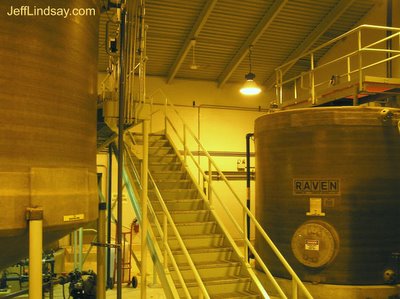Jeff Lindsay is an author of Conquering Innovation Fatigue. See InnovationFatigue.com for more info.
Also follow me on Twitter.
Archives
Appleton Resources
- Appleton, Wisconsin
- Restaurant Reviews
- Appleton.org
- FoxCities.org
- Fox Cities Blog
- Fox Cities Chamber of Commerce
- Lawrence News and Events
- Appleton Area Newcomer's Club
- The Hmong People
- Consumer's Guide to Appleton
- City Parks
- The Post-Crescent
- The Valley Loop
- The Valley Scene
- Performing Arts Center
- Appleton Downtown
- Religion in the Fox Cities
- Appleton Fun
- Photographs of Appleton
Other Suggested Links
Other Blogs from Fox Cities Folks
Thursday, December 08, 2005
Appleton's N.W. Mauthe Superfund Site

This is a view inside a special building built by the EPA for purifying groundwater at the N.W. Mauthe Superfund Site at 725 South Outagamie Street in Appleton, right next to Miller Electric. I toured it tonight and was amazed at the story. There use to be a metal plating facility at this location from 1960 to 1987. Apparently toxic chromium solution, with dangerous hexavalent chromium ions, was simply dumped behind the old building into the soil. This went on for years, resulting in high levels of chromium salts in the soil and causing contamination of the groundwater in the area. Norbert W. Mauthe purchased the property from the Wisconsin Chromium Corporation in 1978.
The Department of Natural Resources investigated a complaint about environmental contamination in 1982. The flyer that the DNR gives to visitors of this facility, dated Dec. 2005, states that Mr. Mauthe "did not take the legally required environmental response" so the DNR took legal action against him in 1982. This dragged on until 1986 when Mr. Mauthe died of cancer, possibly associated with exposure to chromium, and in 1988 the state settled with his estate.
In 1984 the DNR removed contaminated soils and paved the grounds with asphalt to reduce the flow of rainwater into the contaminated region.
The EPA added this site to their Superfund National Priorities List, making it eligible for federal funding. Millions were spent to install the clean-up facility, which has large tanks for pumping in groundwater from multiple collection points in the neighborhood, and for processing the groundwater by reacting it with ferrous sulfate to reduce the chromium to the less toxic trivalent form, which is then precipitated by reaction with alkali to form a sludge. Large quantities of water have been processes continuously since 1998, resulting in a negligible quantity of sludge - apparently just a few dozen pounds so far.
Why is so little chromium being removed? Apparently because the removal of the contaminated soil was so effective that there is very little chromium left in the water to remove. The initial groundwater concentration of chromium back around 1998 was 600,000 parts per billion. After removal of the soil, it dropped dramatically and has been relatively flat at about 600 parts per billion. The acceptable limit for chromium is 100 parts per billion.
Our guide was Jennifer Borski, the DNR project manager responsible for this site. This knowledgeable and dynamic person helped a group of about 50 young people learn more about environmental reclamation. Thanks, Jennifer!
Man, how would you like to have a national Superfund site named after you? I hope my grandchildren don't have to deal with brochures talking about the J.D. Lindsay Superfund Site.


